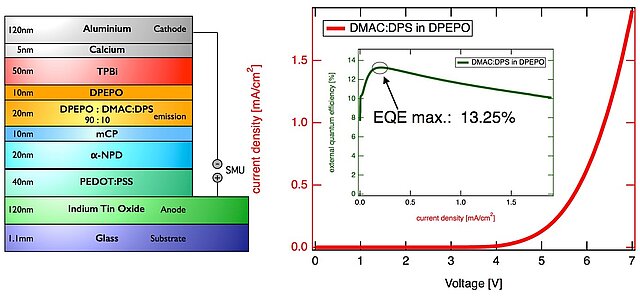Spin Effects in Organic Semiconductors and Devices
(SpinOS Group)
Organic semiconductors are a promising class of materials for the next generation of light emitting diodes (OLED) [1] and solar cells (OPV) [2]. Several phenomena in these semiconductors are related to the spin properties of triplet excitons and charge transfer states that are optically or electrically generated in device active layers and can influence the charge carrier generation and radiative recombination quantum efficiency. In other words, spin is a crucial parameter controlling the physical limits of device quantum efficiency.
The main focus of our research is the development and application of electrical and optical techniques based on electron spin resonance (ESR) to control the spin state and to study its influence on organic semiconductor device efficiency under realistic operating conditions. Understanding of these fundamental processes and their effective quantitative influence is also essential for the practical realization of novel OPV and OLED device concepts, such as up- and down-conversion (triplet fusion, singlet fission), or thermally stimulated triplet-singlet reverse intersystem crossing (RISC), which may redefine the physical limits for organic optoelectronics and photovoltaics in the future.
All steps from device production via solution processing and thermal evaporation to electro-optical efficiency characterization and spin-sensitive investigations are available at our facilities.

OLED device stack produced by evaporation and electro-optical characterization including determination of the external quantum efficiency (EQE).
Literature:
1. Long-lived spin-polarized intermolecular exciplex states in thermally activated delayed fluorescence-based organic light-emitting diodes. S. Weissenseel, A. Gottscholl, R. Bönnighausen, V. Dyakonov, A. Sperlich, Sci. Adv. 7 (47), eabj9961 (2021). [DOI: 10.1126/sciadv.abj9961]
2. Direct Observation of Spin States Involved in Organic Electroluminescence Based on Thermally Activated Delayed Fluorescence. S. Väth, K. Tvingstedt, M. Auth, A. Sperlich, A. Dabuliene, J. V. Grazulevicius, P. Stakhira, V. Cherpak, and V. Dyakonov, Adv. Optical Mater. 5, 1600926 (2016).
3. Triplet Excitons in Highly Efficient Solar Cells Based on the Soluble Small Molecule p-DTS(FBTTh2)2. S. Väth, K. Tvingstedt, A. Baumann, M. C. Heiber, A. Sperlich, J. A. Love, T.-Q. Nguyen, and V. Dyakonov, Adv. Energy Mater. 1602016 (2016).



